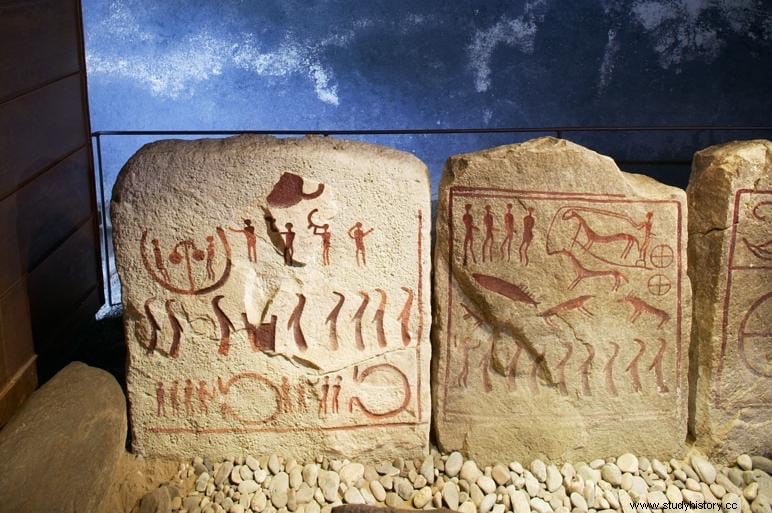Near the town of Kivik and about 320 meters from the coast in Scania, the southern tip of Sweden, there is a circular burial mound that the inhabitants of the place used as a quarry for centuries. In 1748 the quarry had reached the interior of the tumulus, and two farmers who had gone for stone were surprised when they removed some blocks and discovered that there was a huge hole under them.
It turned out to be a funerary chamber 3.25 meters long, oriented from north to south and whose floor was made up of enormous stone slabs in the form of cists (four vertical stones on which another is placed as a lid).
Thinking that underneath there must be a great treasure, they raised the slabs. It's not known for sure if they found anything of value, but what was under there was nothing more than a grave from the Bronze Age.

What they did notice is that the slabs had strange drawings engraved on them. Even so, they did not give them too much importance, they broke some of them and took them to use them as construction material. For some time people continued to carry stones from the burial mound as if nothing had happened.
It would take until 1931 for a comprehensive archaeological excavation by Gustaf Hallström to examine the site. It turned out to be one of the largest burials from the Nordic Bronze Age, dating to around 1400 B.C.
Not only that, it was a double burial, since a second smaller chamber was found, 1.2 meters long by 0.65 meters wide, also with slabs as cists. Therefore, due to the grandeur of the burial mound (which is 75 meters in diameter and one of the largest in Scandinavia), the first was called the King's Tomb, and the second the Prince's Tomb.

Recent studies of the skeletal remains found indicate that at least four people, almost all adolescents, were buried in the tomb in different periods of the Early Bronze Age.
If they had ever contained any items, they had long ago disappeared at the hands of treasure hunters. But another equally important and interesting one for archaeologists had remained almost intact:the tomb slabs contained petroglyphic engravings with representations of people, birds and fish, boats, lures (curved-shaped instruments), symbols and a chariot with four-spoked wheels. pulled by two horses, in what seems to represent a religious ceremony or a kind of procession.

The framing of the figures in the engravings is very special, unknown in the Scandinavian Bronze Age, which differentiates these petroglyphs from others from that same period, such as those of the Sagaholm burial mound, in the town of Jönköping. In contrast, the depiction of horses is consistent with similar finds at Sagaholm itself, Tagaborg, Trundholm, and Klinta, suggesting a uniform stylistic tradition in southern Scandinavia.
As for the symbols that appear in the petroglyphs, some researchers relate them to the commercial travelers of the upper Mediterranean cultures of the time. Thus, the people buried in the Kivik burial mound would have played a role in this long-distance contact.

Kristian Kristiansen and Thomas Larsson, among others, argue that the symbols of double axes and spears would be influenced by royal Hittite symbols. In other engravings, the chariots, bulls and processions would be related to the Mycenaean world. They even compare the stylization of the characters in the procession with similar representations on objects from the same period from Tiryns and other Mycenaean places.

After the excavations, which ended in 1933, the burial mound and the tombs were restored. The reconstruction was mainly based on 18th-century engravings and assumptions made by archaeologists, so the result may not correspond to the original state of the complex. Some scholars suggest that the interior height must have greatly exceeded the current 3.5 meters.
To gain access to the interior, an entrance and a tunnel were built, which allow visitors to contemplate the tombs and petroglyphs in situ, arranged as they should have been originally. Since 2021 the place has been temporarily closed to the public, apparently due to the risk of collapse.
Fonts
Kristian Kristiansen, Thomas B. Larsson , The Rise of Bronze Age Society:Travels, Transmissions and Transformations | Klavs Randsborg , Kivik. Archeology &Iconography . Acta Archaeologica 64, 1, 1993. København:Handelshøjskolens Forlag, 1994. 147 p. | Terry Gunnell , The Origins of Drama in Scandinavia | Andreas Toreld &Tommy Andersson , Ny documentation av Kiviksgravens hällbilder | Kiviksgraven (Official Site) | Wikipedia
